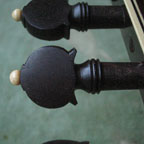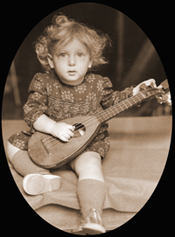What string length for what
pitch? That is the question.The renaissance lute evolved, by the
latter part of the 16C into a family of 7 instruments, used in
various combinations. The Fugger inventory has instruments in seven
sizes, and Praetorius, in Syntagma Musicum, at the beginning
of the 17C also lists this number of lutes, and gives their names
and tunings as follows (the string lengths given are those that I
now use):
|
small octave lute c’’ or d’’
small descant lute b’
descant lute a’
ordinary chorist or alto lute g’
tenor lute e’
bass lute d’
octave great bass lute g
|
(c. 40cm)
(c. 45cm)
(c. 52cm)
(c. 58cm)
(c. 67cm)
(c. 76cm)
(c. 90cm) |
 |
Unfortunately, Praetorius did not give string lengths, and his
pitch was anyway nominal, not absolute. Players were
instructed to tune their top strings, of gut at that time, as high
as they would stand, and the rest at the proper intervals below
this.
Existing old lutes, of the late 16C type, mostly 7c and 8c, that
appear to form part of definite sets of instruments, do fall into a
number of size groups, especially alto, tenor and bass lutes, the
greater part of those surviving. These seem to be around 58 to 60cm, 66 to 70cm
and 76 to 80cm. The top strings of these sizes are quite capable of
being tuned at A440 to g’ e’ and d’ respectively, with a variation
of a semitone or so either side of this.
Lutes, then, are far from standardised, and players need to
experiment with strings and pitch standard to get the best out of
their instrument. For many years lutenists have treated the alto g’
lute of around 60cm as a ‘standard’ instrument, but some recent fine
recordings demonstrate that the lower pitch of the tenor lute can
give a wonderfully warm and sonorous sound quality, quite different
from the brightness of the alto instrument. I feel it may have been
this warm ‘tenor’ quality that so beguiled the players of the French
Baroque, with their long string lengths and low pitches.



From all this you can see that I am very keen to promote the
original string material of the lute, and I do now in fact string
all my instruments in gut, using plain, high twist, and copper
loaded diapasons from several sources. The strings are, after all,
half of the instrument, and the entire history of the lute and its
music is bound up with developments in gut string making and the
sound quality produced by them.
I am certainly not against using other string materials. Cost
after all is sometimes a consideration, and absolute beginners will
for a while prefer them for their stability, but the soft and
sonorous sound of the real thing will I think convince most players
in the end.
